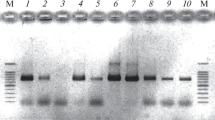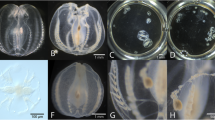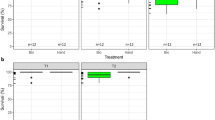Abstract
Daphnia may be preserved without loss of phosphorus or carbon by filtering them onto screens and quickly freezing them in the absence of excess water. Length is unaffected by the process and eggs and young may be counted accurately.
Similar content being viewed by others
References
Downing, J. A. & R. H. Peters, 1980. The effect of body size and food concentration on the in situ filtering rate of Sida crystallina. Limnol. Oceanogr. 25: 883–895.
Holtby, L. B. & R. Knoechel, 1981. Zooplankton filtering rates: error due to loss of radioisotopic label in chemically preserved samples. Limnol. Oceanogr. 26: 774–780.
Persson, G., 1982. Losses of isotopic label upon liquid preservation of zooplankton in feeding and assimilation studies. Arch. Hydrobiol. 94: 502–519.
Author information
Authors and Affiliations
Additional information
Financial support provided by NSF Grant # BSR-8407431.
Contribution # 362 from the Limnological Research Center.
Contribution # 362 from the Limnological Research Center.
Rights and permissions
About this article
Cite this article
Shapiro, J., Wright, D. Successful preservation of Daphnia for chemical and physical analysis. Hydrobiologia 175, 61–63 (1989). https://doi.org/10.1007/BF00008475
Received:
Accepted:
Issue Date:
DOI: https://doi.org/10.1007/BF00008475




